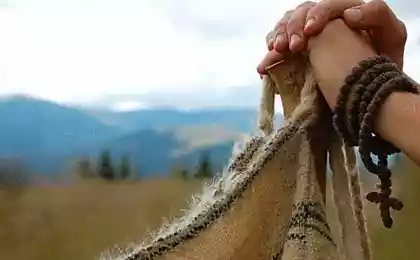729
9 facts about the human superpowers

1. SupervkusLyudey who feel the taste is much more accurate than the rest of the population, called superdegustatorami. The reason is the presence of an additional build-up mushroom (growths on the tongue in the shape of mushrooms, which are covered with extra taste buds) - that's why these people have a strong reaction to the taste. Of the five basic tastes: sweet, salty, bitter, sour and umami, bitter superdegustatory considered the most prominent.
Superdegustatory do not like certain foods, particularly bitter, such as Brussels sprouts, cabbage ordinary, coffee and grapefruit juice. Women, Asians, Africans, and more likely to be superdegustatorami, because they have a high probability of an increased number of mushroom-shaped growths.
2. Absolute sluhLyudi with perfect pitch are able to identify and reproduce the tone. This is not just an improved ability to hear, but the ability to mentally categorize sounds, remembering their categories. Examples demonstrating absolute pitch can be the identification of everyday noises (eg horns, sirens, the sound of the engine), the opportunity to sing a note without original song called chords. Take any example of this list is an indication that a person remembers the frequency of each tone and can call it (for example, 'C #', or 'C sharp'). Opinions on the bill, whether absolute pitch ability of genetic or not, are constantly changing. Estimates of the population having absolute pitch range from 3% (in the US) to 8% (in Europe).
3. SvetovospriyatieSvetovospriyatie - the ability to see light from four different sources. An example of this in the animal kingdom - zebra fish that could see the light of red, green, blue and ultraviolet range of the light spectrum. True svetovospriyatie in humans is much rarer, however, according to Wikipedia, it has been reported two cases of this phenomenon.
Ordinary people have three types of receptors that recognize the light in the red, green and blue range of the light spectrum. Each receptor can recognize about 100 shades of color, and our brain tries to mix them up, change their brightness, so that we can observe at least part of the 1 million different colors that painted our world. True svetovospriyatie theoretically allows to perceive 100 million colors.
4. EholokatsiyaEholokatsiya - is what helps bats navigate in the dark forests - they emit a sound, waiting for the echo, and use sound in the ears of returning them to determine where the object is. Surprisingly, people are also capable of echolocation. She is likely to have access to blind people, because the whole process is time consuming and a strong sensitivity to sound reflection.
To use echolocation, a person actively creates noise (for example, clicking the tongue), and thanks to echo understands how objects are arranged around it. People who are capable of it, can determine where the object is located and what size it is. Since a person can not make or hear the sound at high frequencies, which are used bats and dolphins, he will be able to locate only large objects, unlike animals ekolokatorov.
5. Genetic HimerizmV Iliad Homer described a creature having body parts from different animals - a chimera. It is from the name of a mythological monster came to the name of one of the genetic phenomena - chimerism. Genetic chimerism or tetragametizm manifest in humans and animals, in cases where two fertilized eggs or embryos are joined together in the early stages of pregnancy. Each zygote carries a copy of the DNA of one of the parents, which means that two different genetic materials. When they merge, the contents of cells retains its genetic character and the resulting embryo becomes a mixture of both. Essentially, a human chimera - own twin.
Chimerism in humans is very rare. Wikipedia says that only 40 known cases. DNA analysis is often used to determine whether the person biologically with his parents or children, but it can and uncover cases of chimerism when DNA results show that children are not biologically related to their mothers - because the child inherited a different DNA profile. This happened in the case of Lydia Fairchild: DNA tests of her and her children have forced the state to think that she was not their mother.
6. SinesteziyaPredstavte yourself that each digit and the letter you associate with a particular color, or a word makes you a certain sense of taste. This is - the two forms of a neurological disorder called synesthesia. Synesthesia - the excitement is when one sensor entails an involuntary reaction of other sensors.
Synesthesia is most often genetic features manifested in connection letters or numbers with certain colors.
Although synaesthesia - a neurological disorder, it does not make a person an invalid, because it does not affect his ability. Most people do not even know that the events of their lives evoke sensory responses greater than that of others. Basically, those who have synesthesia, do not believe that it has a negative impact on their lives.
7. People-kalkulyatorySamaya extraordinary group of experts who are able to perform complex calculations in his mind - people with autism ... In total there are fewer than 100 recognized by the world's foremost scholars and scientists with autism who can use mental methods of calculation. A recent study found that one of the factors that allows mental calculators to solve math problem much faster than the average person, is that blood flow to part of the brain responsible for mathematical calculations, such people exceeds the rate of six or seven times.
8. SuperpamyatKogda man has a photographic memory - it is called a living memory. This ability to recall sounds, images, or objects with extreme accuracy. His living memory showed Akira Haraguchi, who could remember the first 100,000 digits of pi. Figures Vilchira Stephen (who was also autistic) are also an example of the living memory - in these figures is depicted his stay in Rome. Raymond Babbit in the movie "Rain Man", also has a living memory and, among other things, he can recall about 12,000 books from memory.
Is there a true photographic memory, is still a controversial issue, but recognized that the ability to live the memory evenly distributed between men and women. Living memory is also impossible to get through practice.
9. Immortal kletkiEst only one known case of a person having immortal cells (cells that can divide indefinitely outside of the human body), and that a woman named Henrietta Lacks. In 1951, at the 31-year-old Henrietta Lacks was diagnosed with cervical cancer, and after a year of serious illness she died. Unknown to her and her family a surgeon took a tissue sample of the tumor it (without getting the informed consent of relatives), which was transferred to Dr. George Ki. Scholarships for university laboratory tissue culture them. Johns Hopkins breeding Henrietta tissue sample into an endless cell line - a line Hela. Cells from the tumor Lax was active form of the enzyme, which is spreading rapidly wrong. On the day of the death of Henrietta Lacks Dr. Guy announced to the world that a new age has begun in the medical issledovanii- one that could provide cancer treatment.
Hela cells are now very common in laboratories. For today Hela cells alive even more than during the life of Henrietta Lacks - they outweigh its physical mass many times. Unfortunately, she will never know about a very valuable contribution to the science that made her cells.
Hela cells were used in 1954, Jonas Salk to develop a treatment for polio. Since then, they have been used in cancer research, AIDS, the effects of radiation and toxic substances and by the way, also for cloning.
Source: www.mindhobby.com
via factroom.ru























